Study of Wellbore Instability and Collapse Mechanism for a Layered Continental Shale Oil Horizontal Well
Abstract
:1. Introduction
2. Rock Mechanics Experiments of Layered Shale
2.1. Experimental Core Preparation
2.2. Triaxial Compressive Strength Test
2.3. Tensile Strength Test of Shale
3. Prediction Model of the Collapse Pressure of a Horizontal Well in Layered Shale
3.1. Borehole Stress Considering Hydration Strain
3.2. Wellbore Circumferential Stress Produced by In Situ Stress
3.3. Total Effective Stress of Wellbore
3.4. Determination of Collapse Pressure
3.5. Solution of Collapse Pressure Model
4. Analysis of Influencing Factors of Wellbore Instability in Layered Shale
4.1. Influence of In Situ Stress Conditions on Collapse Pressure
4.2. Influence of Water Content on Collapse Pressure
4.3. Influence of the Number of Structural Planes on Collapse Pressure
5. Oilfield Case Analysis
6. Conclusions
- The analysis shows that no matter under which in situ stress mechanism, the wellbore in the vertical well section is the most stable, and when the inclination angle is approximately 45°, the wellbore is most likely to be unstable.
- Changes in water content do not affect the most stable or unstable regions. Under the same conditions, the equivalent density of collapse pressure increases with the increase in water content.
- Since water-based drilling fluids are used to drill into layered shale formations, the hydration strain has a greater impact on the equivalent density of collapse pressure. Therefore, it is suggested that the influence of hydration on rock mechanical parameters and the influence of hydration expansion stress should be considered when designing the density of drilling fluid. During the drilling process, it is necessary to strictly control the filtration loss of the drilling fluid and improve the inhibition of the drilling fluid to reduce the water content of the formation, reduce the hydration strain, and ensure the stability of the wellbore.
- The results of this study are basically consistent with the previous research conclusions. However, the research results of this paper are more suitable for a layered continental shale oil horizontal well in the establishment of theoretical model and the final conclusion, and are demonstrated with field examples.
Author Contributions
Funding
Institutional Review Board Statement
Informed Consent Statement
Data Availability Statement
Conflicts of Interest
References
- Wen, C.; Wei, L. The Wellbore Stability Study in Bedding Shale Formation on the Condition of Plasticity. Chem. Technol. Fuels Oil 2022, 58, 220–231. [Google Scholar]
- Ewy, R.T. Wellbore Stability Predictions by Use of a Modified Lade Criterion. SPE Drill. Completion 1999, 14, 85–91. [Google Scholar] [CrossRef]
- Bo, K.H.; Jin, Y.; Lu, Y.H.; Liu, H.T.; Zhu, J.Z. A Quantitative Evaluation Method of Anti-Sloughing Drilling Fluid Inhibition for Deep Mudstone. Energies 2022, 15, 1226. [Google Scholar] [CrossRef]
- Ding, L.Q.; Wang, Z.Q.; Lv, J.G.; Wang, Y.; Liu, B.L. A New Model for Real-Time Prediction of Wellbore Stability Considering Elastic and Strength Anisotropy of Bedding Formation. Energies 2021, 15, 251. [Google Scholar] [CrossRef]
- Zhang, F.; Liu, H.B.; Cui, S.; Meng, Y.F.; Wang, J.J. Influence of the Weakening Effect of Drilling Fluid on Wellbore Stability in Anisotropic Shale Formation. Front. Phys.-Lausanne 2021, 9, 541. [Google Scholar] [CrossRef]
- Liu, Z.Y.; Pan, Z.J.; Li, S.B.; Zhang, L.G.; Wang, F.S.; Han, L.L.; Zhang, J.; Ma, Y.Y.; Li, H.; Li, W. Study on the effect of cemented natural fractures on hydraulic fracture propagation in volcanic reservoirs. Energy 2022, 241, 122845. [Google Scholar] [CrossRef]
- Cao, G.; Cheng, Q.; Liu, Y.; Bu, R.; Zhang, N.; Wang, P. Influencing Factors of Surfactant Stripping Crude Oil and Spontaneous Imbibition Mechanism of Surfactants in a Tight Reservoir. ACS Omega 2022, 7, 19010–19020. [Google Scholar] [CrossRef]
- Han, L.L.; Li, X.Z.; Guo, W.; Ju, W.; Cui, Y.; Liu, Z.Y.; Qian, C.; Shen, W.J. Characteristics and Dominant Factors for Natural Fractures in Deep Shale Gas Reservoirs: A Case Study of the Wufeng Longmaxi Formations in Luzhou Block, Southern China. Lithosphere 2022, 2022, 9662175. [Google Scholar] [CrossRef]
- Li, X.R.; Zhang, C.F.; Feng, Y.C.; Wei, Y.R.; Chen, X.P.; Weng, H.Y.; Deng, J.G. An integrated geomechanics approach to evaluate and manage wellbore stability in a deep graben formation in Tarim Basin. J. Pet. Sci. Eng. 2022, 208, 109391. [Google Scholar] [CrossRef]
- Gao, C.; Miska, S.; Yu, M.J.; Dokhani, V.; Ozbayoglu, E.; Takach, N. Experimental and numerical analysis of effective enhancement of wellbore stability in shales with nanoparticles. J. Nat. Gas Sci. Eng. 2021, 95, 104197. [Google Scholar] [CrossRef]
- Deng, J.; Liu, W.; Yu, B.; Tan, Q.; Yang, L. Pore pressure and stress distribution analysis around an inclined wellbore in a transversely isotropic formation based on the fully coupled chemo-thermo-poroelastic theory. J. Nat. Gas Sci. Eng. 2017, 40, 24–37. [Google Scholar]
- Epelle, E.I.; Gerogiorgis, D.I. A review of technological advances and open challenges for oil and gas drilling systems engineering. AIChE J. 2020, 66, e16842. [Google Scholar] [CrossRef]
- Tavallali, M.S.; Karimi, I.A.; Baxendale, D. Process systems engineering perspective on the planning and development of oil fields. AIChE J. 2016, 62, 2586–2604. [Google Scholar] [CrossRef]
- Asaka, M.; Holt, R.M. Anisotropic wellbore stability analysis: Impact on failure prediction. Rock Mech. Rock Eng. 2020, 54, 583–605. [Google Scholar] [CrossRef]
- Ding, Y.; Liu, X.J.; Luo, P.Y. The analytical model for horizontal wellbore stability in anisotropic shale reservoir. Geotech. Geol. Eng. 2020, 38, 5109–5126. [Google Scholar] [CrossRef]
- Ibrahim, A. A review of mathematical modelling approaches to tackling wellbore instability in shale formations. J. Nat. Gas Sci. Eng. 2021, 89, 103870. [Google Scholar] [CrossRef]
- Kang, Q.; Chen, M.; Yan, J.; Zhang, F. Stability model of borehole wall during the well test after acidizing treatment of sandstone reservoirs. Pet. Explor. Dev. 2011, 38, 589–593. [Google Scholar]
- Jaeger, J.C. Shear failure of anistropic rocks. Geol. Mag. 1960, 97, 65–72. [Google Scholar] [CrossRef]
- Liu, X.J.; Zeng, W.; Liang, L.X.; Lei, M. Wellbore stability analysis for horizontal wells in shale formations. J. Nat. Gas Sci. Eng. 2016, 31, 1–8. [Google Scholar] [CrossRef]
- Liu, J.; Yang, Z.; Sun, J.S.; Dai, Z.; You, Q. Experimental investigation on hydration mechanism of sichuan shale (China). J. Pet. Sci. Eng. 2021, 201, 108421. [Google Scholar] [CrossRef]
- Shuai, H.; Yang, C.H.; Zhang, B.P.; Guo, Y.T.; Wang, L.; Wei, Y.L. Experimental research on anisotropic properties of shale. Rock Soil Mech. 2015, 36, 609–616. [Google Scholar]
- Ma, Y.Y.; Li, S.B.; Zhang, L.G.; Liu, S.Z.; Liu, Z.Y.; Li, H.; Shi, E.X. Study on the effect of well layout schemes and fracture parameters on the heat extraction performance of enhanced geothermal system in fractured reservoir. Energy 2020, 202, 117811. [Google Scholar] [CrossRef]
- Aadnoy, B. Modeling of the stability of highly inclined boreholes in anisotropic rock formations. SPE Drill. Eng. 1988, 3, 259–268. [Google Scholar] [CrossRef]
- Ma, T.S.; Chen, P. A wellbore stability analysis model with chemical-mechanical coupling for shale gas reservoirs. J. Nat. Gas Sci. Eng. 2015, 26, 72–98. [Google Scholar] [CrossRef]
- Ma, T.S.; Chen, P.; Zhang, Q.B.; Zhao, J. A novel collapse pressure model with mechanical-chemical coupling in shale gas formations with multi-weakness planes. J. Nat. Gas Sci. Eng. 2016, 36, 1151–1177. [Google Scholar] [CrossRef]
- Ma, T.S.; Liu, Y.; Chen, P.; Wu, B.; Fu, J.; Guo, Z. Fracture-initiation pressure prediction for transversely isotropic formations. J. Pet. Sci. Eng. 2019, 176, 821–835. [Google Scholar] [CrossRef]
- Ma, T.S.; Zou, J.; Chen, P.; Liu, H. Investigation on the influence coupling drilling fluid and formation boundary on acoustic wave propagation in drill string. Geomech. Geophys. Geo-Energy Geo-Resour. 2020, 6, 35. [Google Scholar] [CrossRef]
- Peng, N.; Ma, T.S.; Chen, P.; Liu, Y. Pore pressure evaluation of formation testing while drilling under supercharged conditions. J. Petrol. Sci. Eng. 2021, 203, 108689. [Google Scholar] [CrossRef]
- Epelle, E.I.; Gerogiorgis, D.I. Optimal rate allocation for production and injection wells in an oil and gas field for enhanced profitability. AICHE J. 2019, 65, e16592. [Google Scholar] [CrossRef] [Green Version]
- Liang, C.; Chen, M.; Jin, Y.; Lu, Y. Wellbore stability model for shale gas reservoir considering the coupling of multi-weakness planes and porous flow. J. Nat. Gas Sci. Eng. 2014, 21, 364–378. [Google Scholar] [CrossRef]
- Lee, B.H. Borehole breakouts and compaction bands in two high porosity sandstones. Int. J. Rock Mech. Min. 2004, 41, 287–301. [Google Scholar]
- Epelle, E.I.; Gerogiorgis, D.I. A Multiperiod Optimisation Approach to Enhance Oil Field Productivity during Secondary Petroleum Production. Comput. Aided Chem. Eng. 2019, 46, 1651–1656. [Google Scholar]
- McConnell, D.R.; Zhang, Z.; Boswell, R. Review of progress in evaluating gas hydrate drilling hazards. Mar. Petrol. Geol. 2012, 34, 209–223. [Google Scholar] [CrossRef]
- Epelle, E.I.; Gerogiorgis, D.I. A multiparametric CFD analysis of multiphase annular flows for oil and gas drilling applications. Comput. Chem. Eng. 2017, 106, 645–661. [Google Scholar] [CrossRef] [Green Version]
- Li, S.B.; Liang, K.; Wang, C.H.; Jiao, Y.X.; Liu, H.G.; Wang, C.H. Study on the mechanism of anisotropic wellbore instability in continental shale in Songliao Basin. J. Petrol. Explor. Prod. Technol. 2022. [Google Scholar] [CrossRef]
- Zhi, G.; Chen, M.; Yan, J.; Shuai, Y.; Du, X. Experimental study of brittleness anisotropy of shale in triaxial compression. J. Nat. Gas Sci. Eng. 2016, 36, 510–518. [Google Scholar]
- Zeynali, M.E. Mechanical and physico-chemical aspects of wellbore stability during drilling operations. J. Pet. Sci. Eng. 2012, 82–83, 120–124. [Google Scholar] [CrossRef]
- Chen, P.; Ma, T.S.; Xia, H. A collapse pressure prediction model of horizontal shale gas wells with multiple weak planes. Nat. Gas Ind. 2015, 2, 101–107. [Google Scholar] [CrossRef] [Green Version]
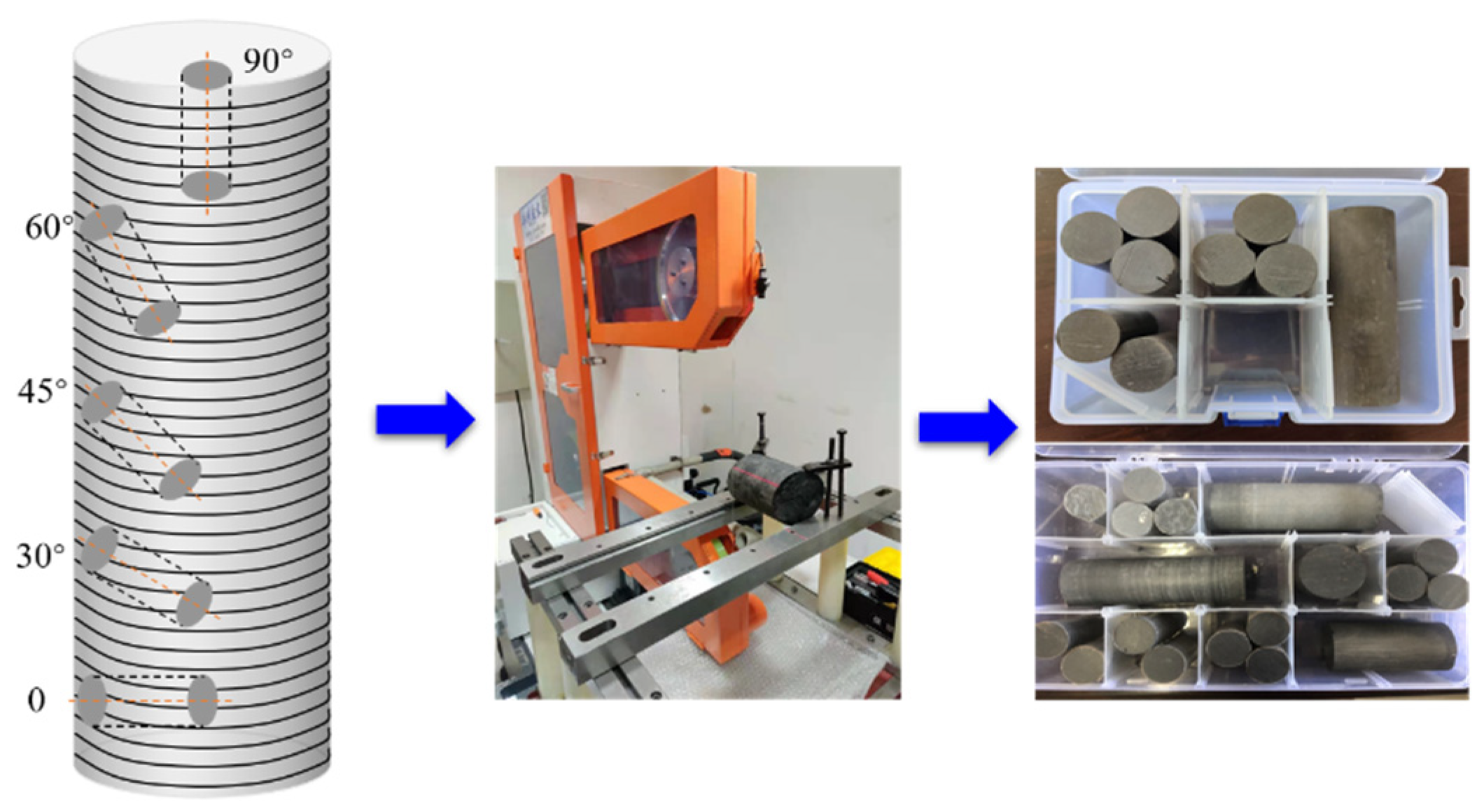

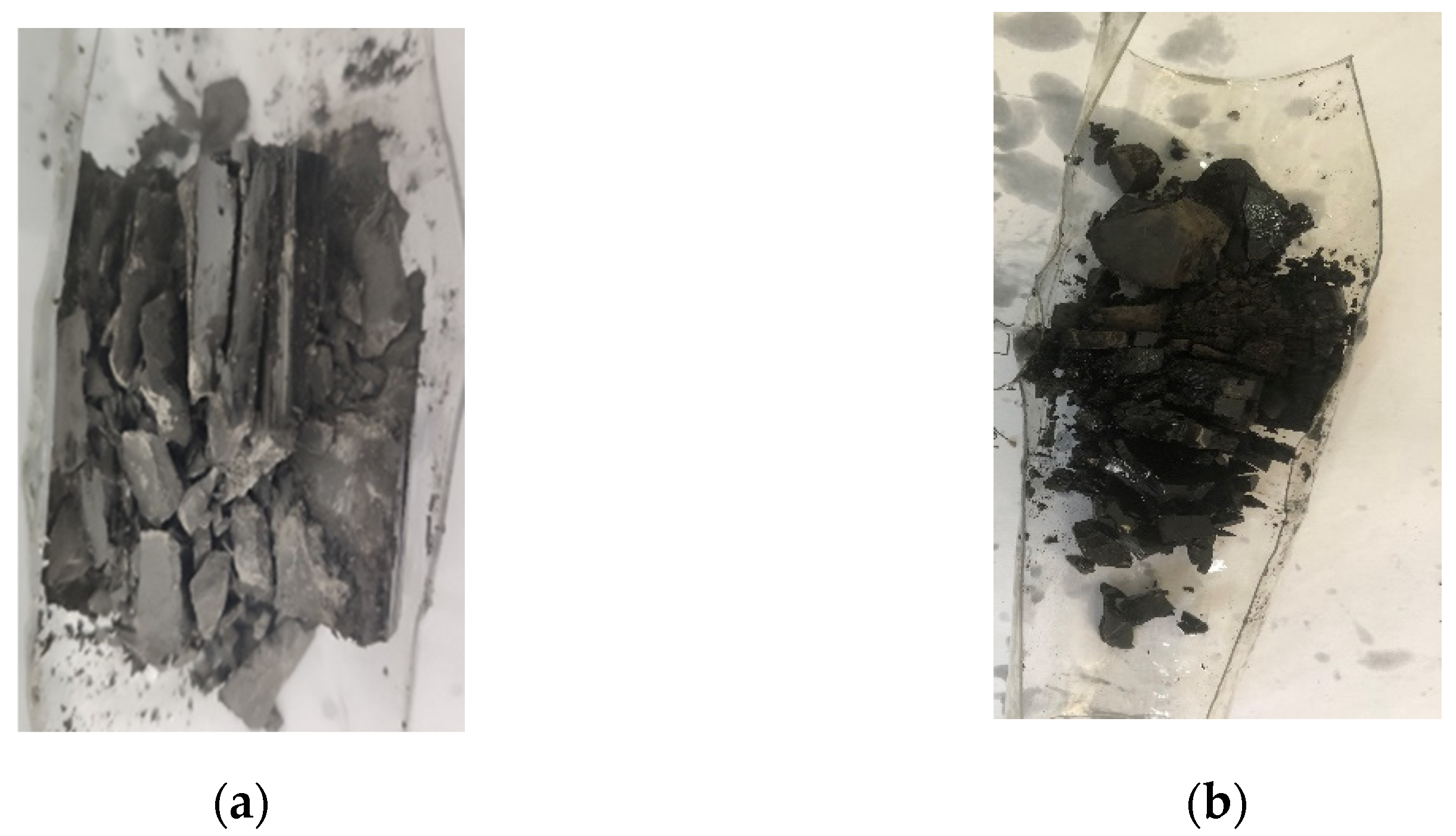
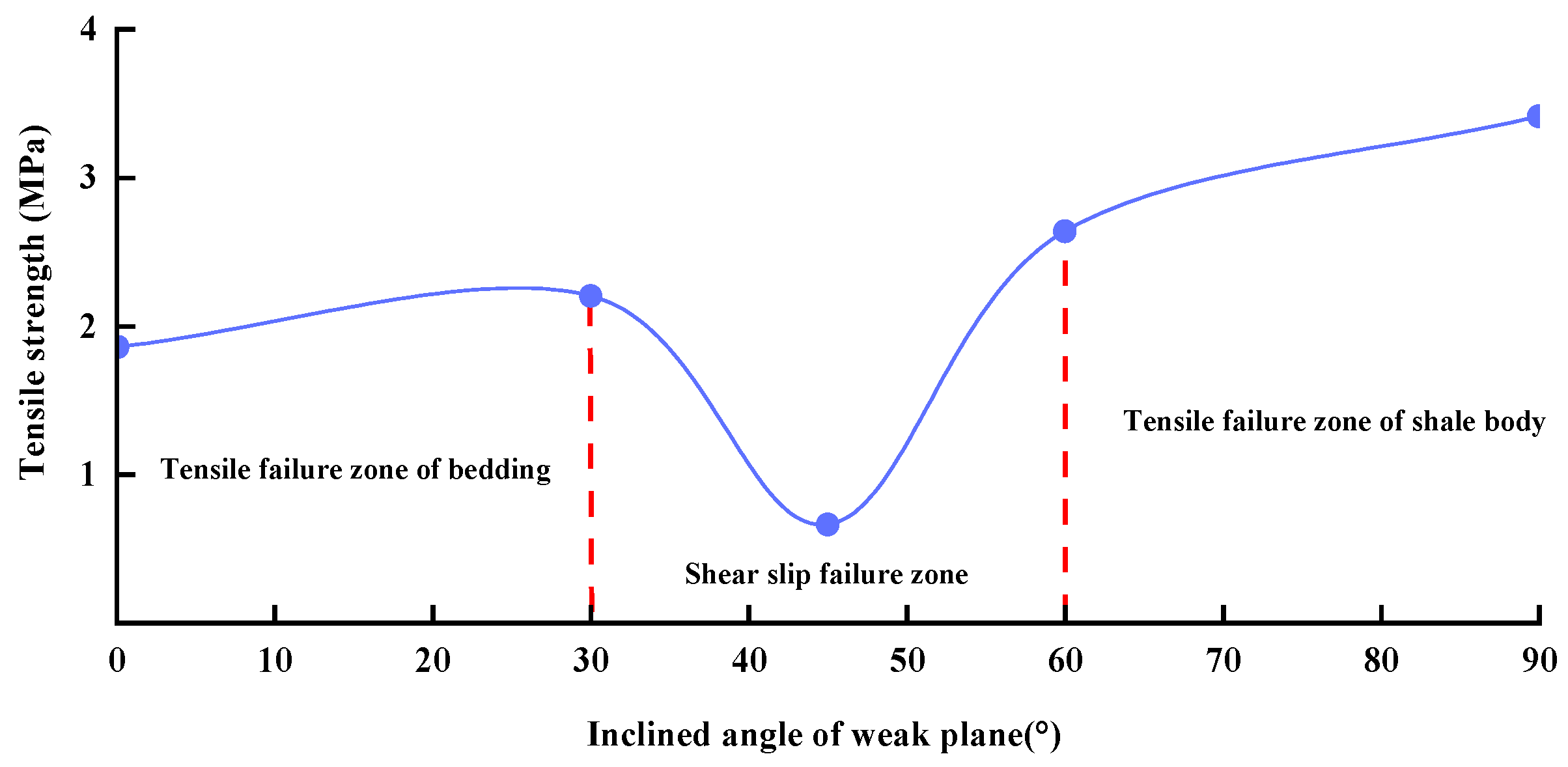

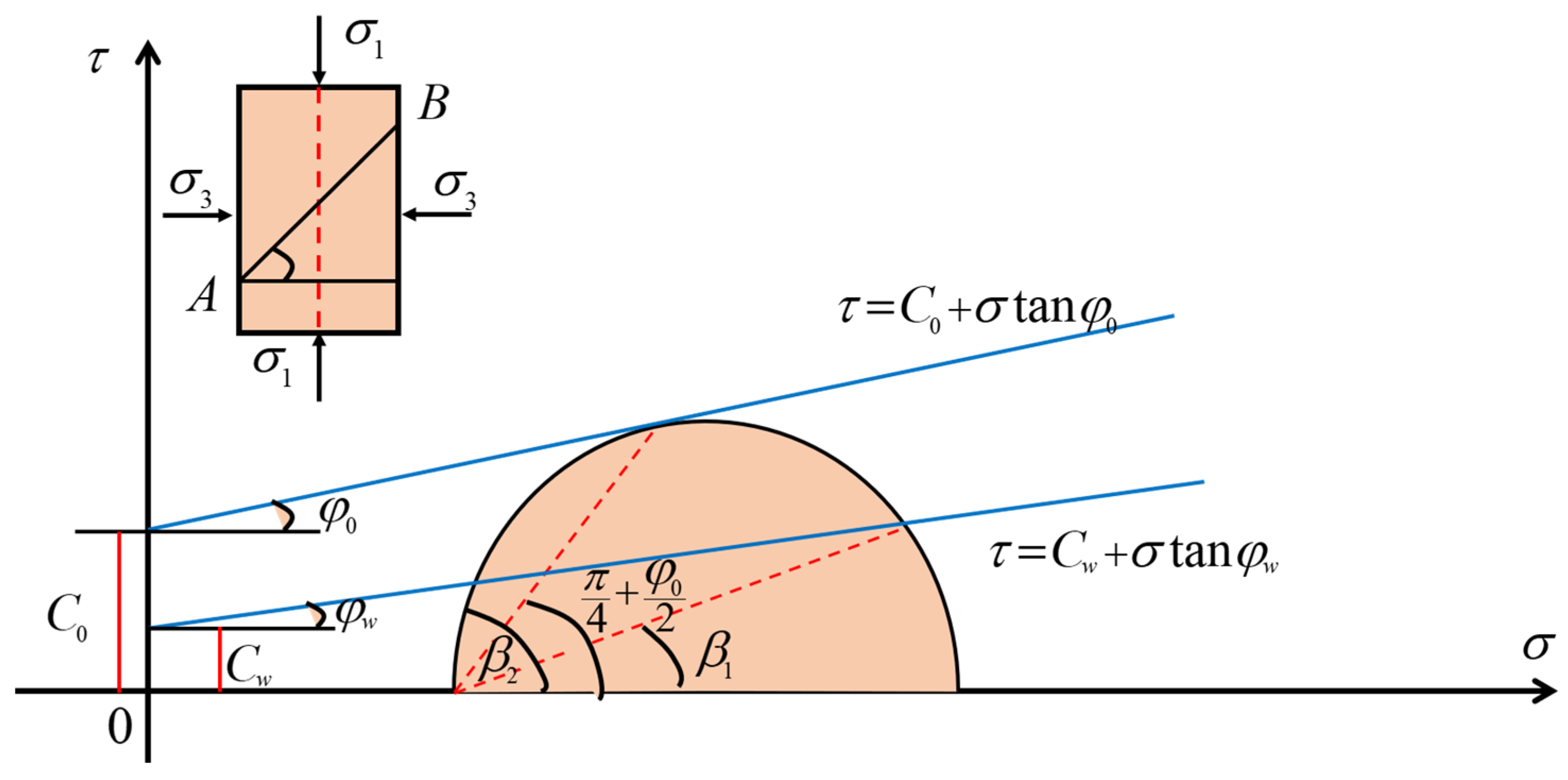

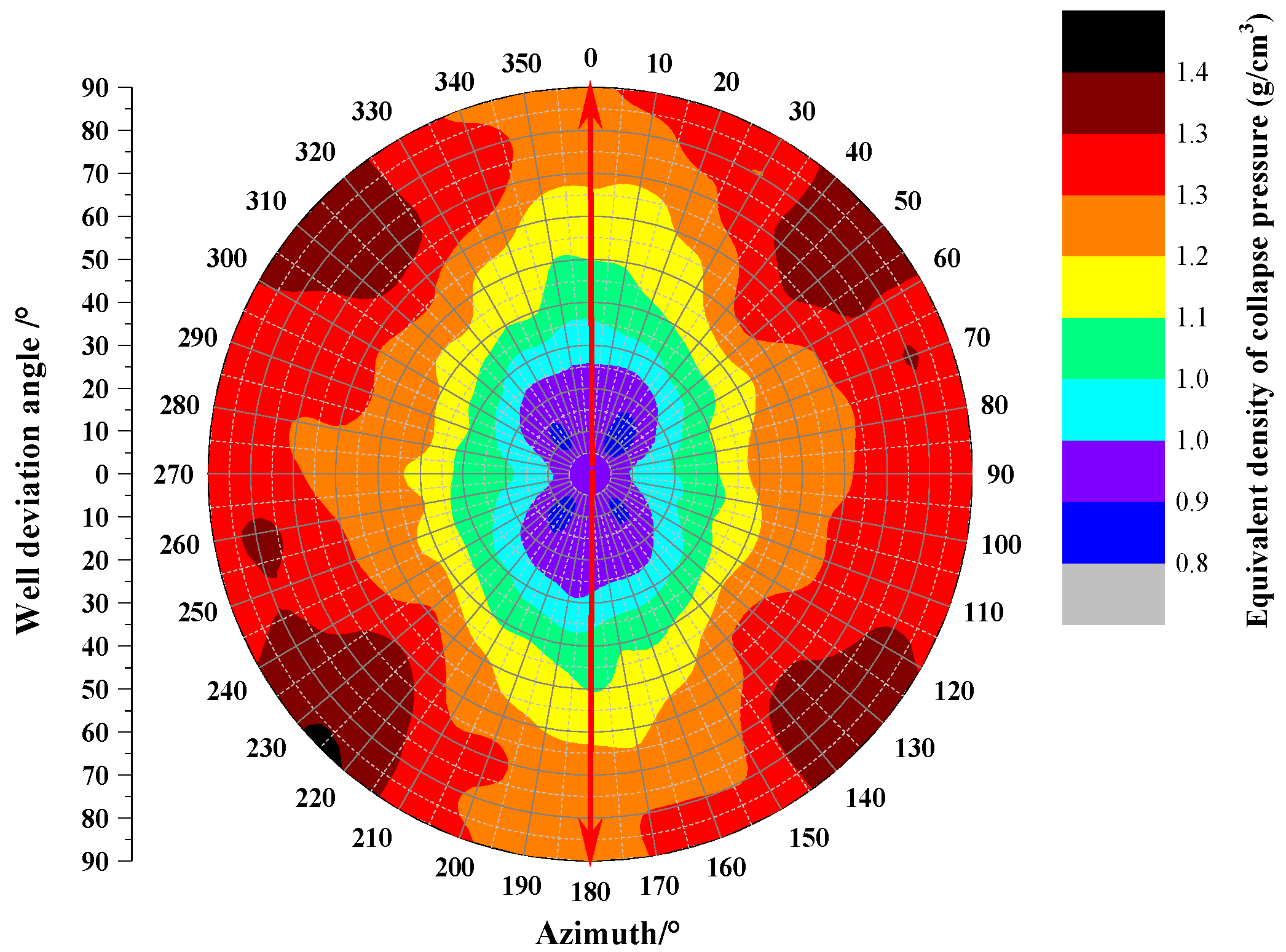
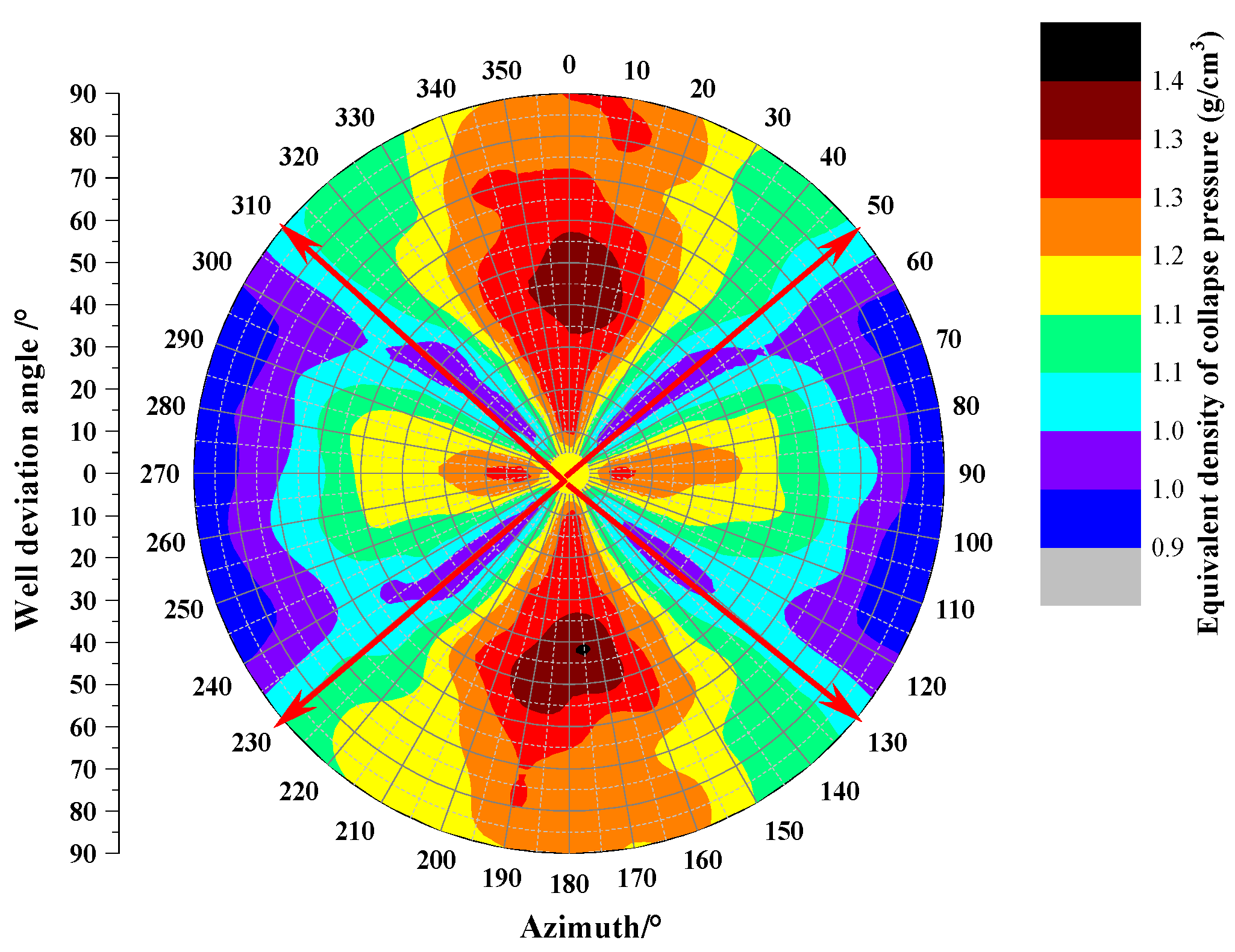

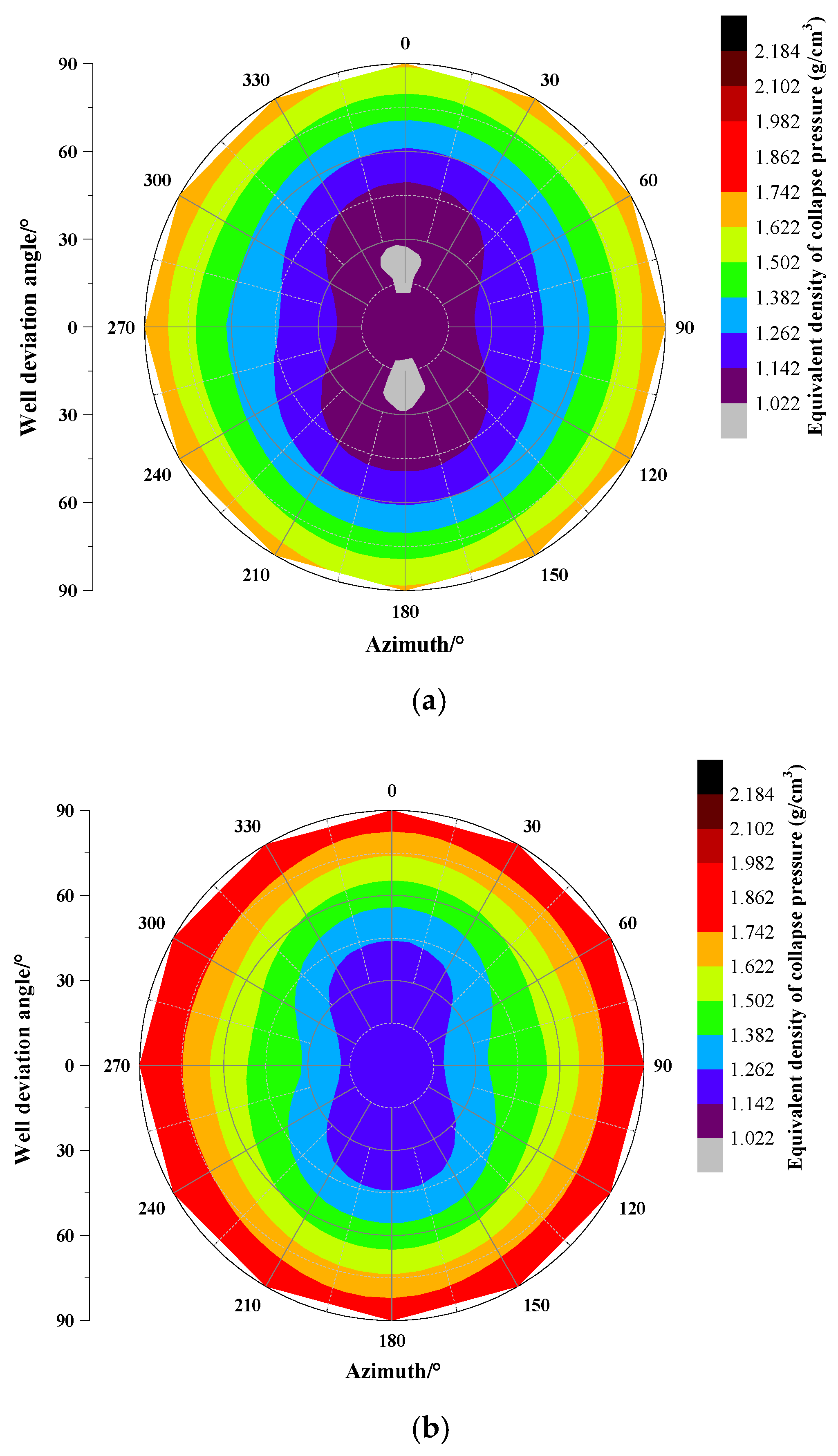
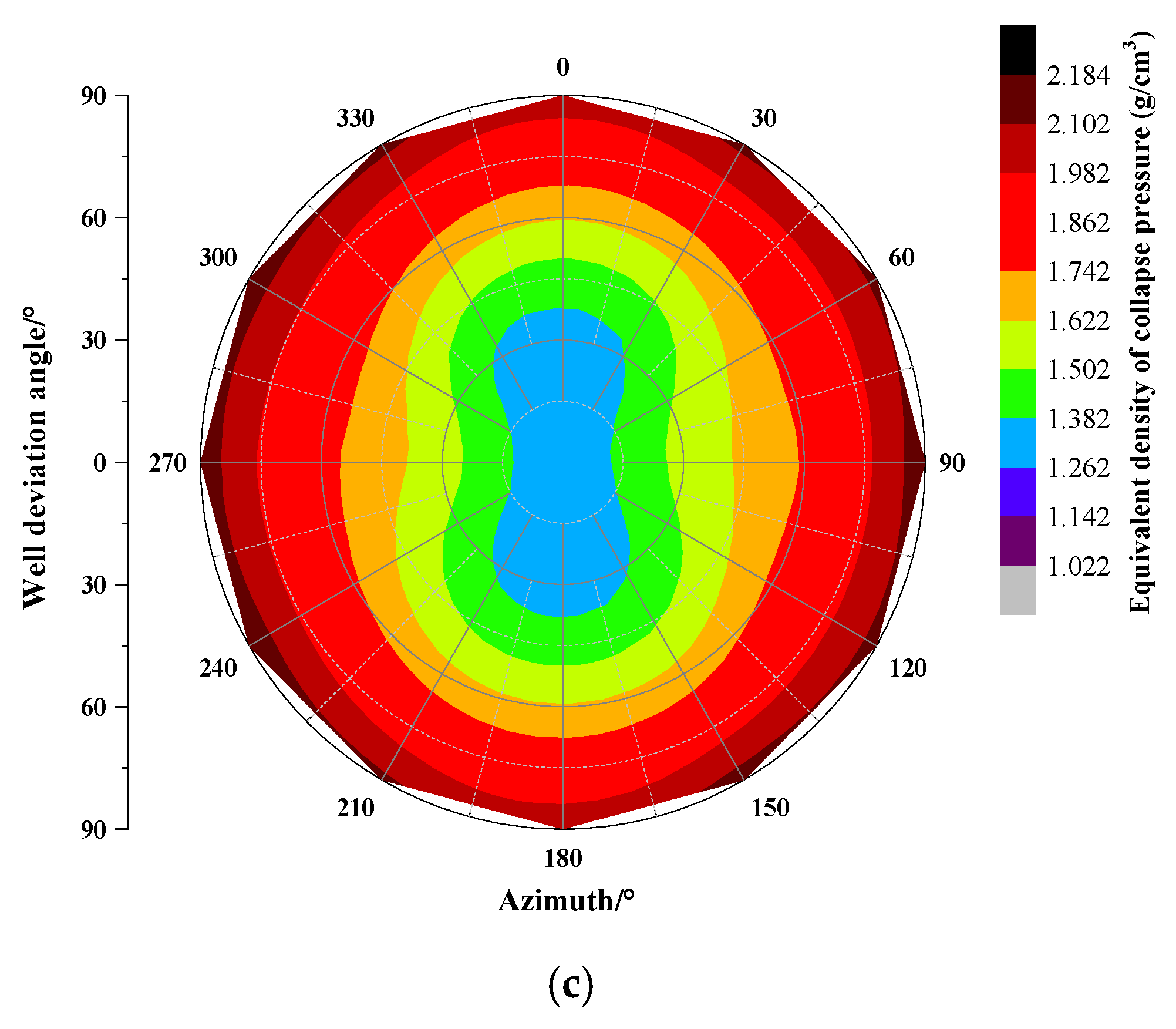
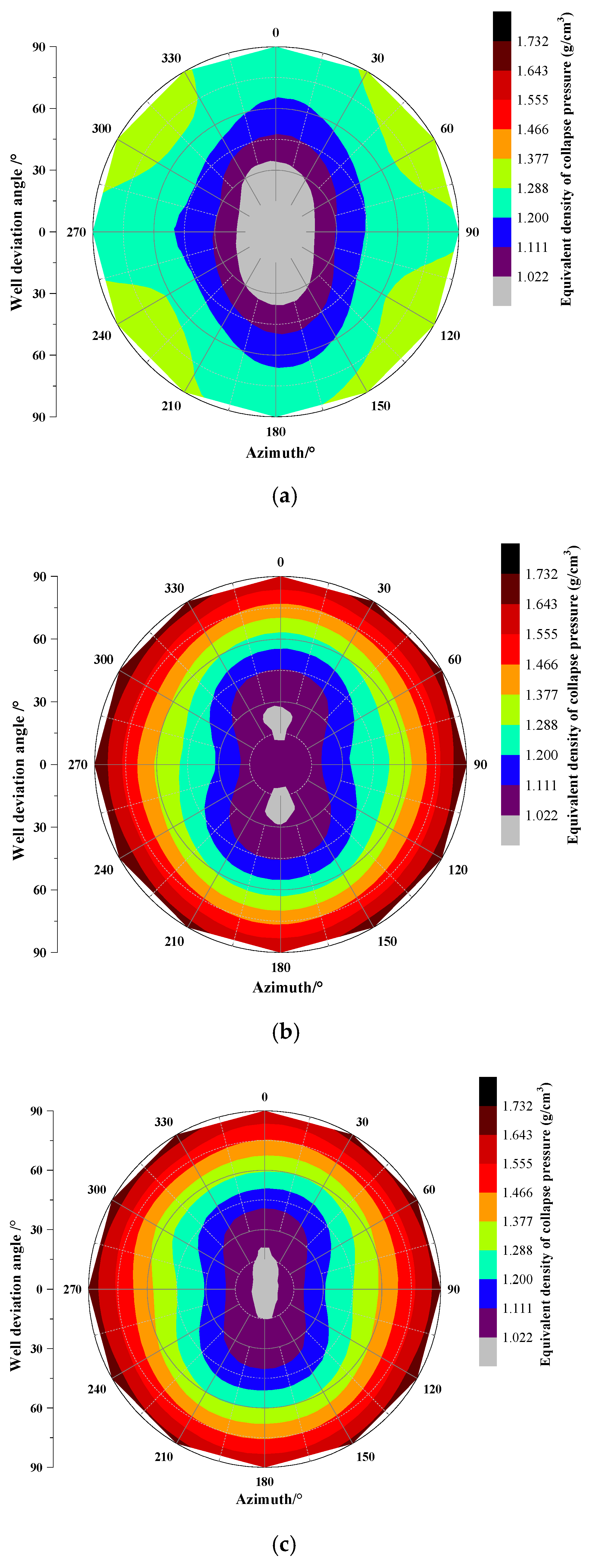

| Serial Number | Parameters | Numerical Value |
|---|---|---|
| 1 | vertical depth/m | 2422.0 |
| 2 | overburden pressure/MPa | 74.03 |
| 3 | horizontal maximum in situ stress/MPa | 64.06 |
| 4 | horizontal minimum in situ stress/MPa | 54.23 |
| 5 | pore pressure/MPa | 21.62 |
| 6 | Biot’s coefficient | 0.79 |
| 7 | initial Poisson ratio | 0.21 |
| 8 | water content of original stratum | 0.032 |
| 9 | water content of wellbore | 0.052 |
| 10 | initial cohesion of shale body/MPa | 16.52 |
| 11 | initial internal friction angle of shale body/° | 32.73 |
| 12 | cohesion of weak plane/MPa | 3.28 |
| 13 | internal friction angle of weak plane/° | 23.87 |
| 14 | dip angle of weak plane/° | 3 |
| 15 | tendency of weak plane/° | 137 |
| 16 | anisotropic ratio of formation | 0.71 |
| 17 | well deviation angle/° | 0°~90° |
| 18 | azimuth/° | 0°~360° |
| Well Name | Whether to Use the Model Correction of this Paper | Drilling Situation |
|---|---|---|
| A1 | NO | The wellbore is unstable, collapses, and the well is closed for sidetracking. |
| Y6 | NO | The wellbore peels off and blocks, the tripping is not smooth, and the drilling speed is slow. |
| G3 | YES | The drilling operation is smooth and the drilling period is less than 15 days. |
Publisher’s Note: MDPI stays neutral with regard to jurisdictional claims in published maps and institutional affiliations. |
© 2022 by the authors. Licensee MDPI, Basel, Switzerland. This article is an open access article distributed under the terms and conditions of the Creative Commons Attribution (CC BY) license (https://creativecommons.org/licenses/by/4.0/).
Share and Cite
Li, S.; Liang, K.; Wang, C.; Wang, Y.; Jiao, Y.; Zhu, X.; Wang, C. Study of Wellbore Instability and Collapse Mechanism for a Layered Continental Shale Oil Horizontal Well. Energies 2022, 15, 4538. https://doi.org/10.3390/en15134538
Li S, Liang K, Wang C, Wang Y, Jiao Y, Zhu X, Wang C. Study of Wellbore Instability and Collapse Mechanism for a Layered Continental Shale Oil Horizontal Well. Energies. 2022; 15(13):4538. https://doi.org/10.3390/en15134538
Chicago/Turabian StyleLi, Shibin, Kai Liang, Changhao Wang, Yao Wang, Yuxuan Jiao, Xiaoxing Zhu, and Chunhua Wang. 2022. "Study of Wellbore Instability and Collapse Mechanism for a Layered Continental Shale Oil Horizontal Well" Energies 15, no. 13: 4538. https://doi.org/10.3390/en15134538





